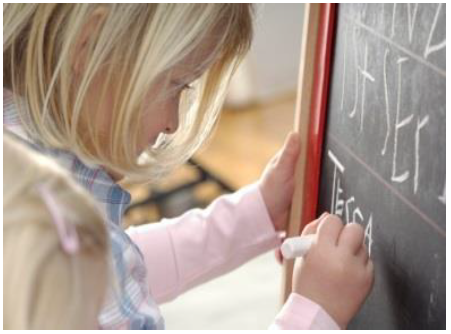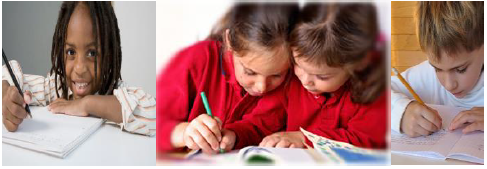Stages of Emergent Writing
Emergent writing describes young children’s attempts at writing (Mayer, 2007). Children start to learn that different symbols represent letters and numbers. Emergent writing progresses along a developmental continuum. Young children (ages 2 to 5 years) commonly move through several stages of writing beginning with random marks and ending with conventional writing (Baghban, 2007; Dennis & Votteler, 2012). Four of the stages are highlighted below.
Awareness, Exploration or Scribbling Stage: This stage begins with children drawing pictures to represent concepts. As they become aware that print carries a message, children begin to make random marks or scribbles that have meaning to them (such as, “This says I like cats.”). Children’s wavy scribbles appear to model cursive writing and include mock letters.
Emergent or Experimental Writing Stage: At the beginning of this stage, children write letter-like forms (mock letters) using shapes that resemble letters. They generally print from left to right. It is common to see random strings of letters as children move from mock letters to real letters.
Transitional or Early Writing Stage: Children write using inventive spelling (clusters of letter-like symbols grouped together to form made-up words and phrases) or phonetic spelling (words created based on a child’s understanding of letter sounds) as they connect letters with sounds. One letter may signify an entire word or syllable. The first or last sounds of a word are usually represented. Children might begin to use punctuation, capital letters and spacing between words. They understand that writing has a purpose and write about topics of personal interest.
Conventional Writing Stage: During this stage, children become proficient at writing letters. They spell their names and other words correctly.

Supporting Early Writing Development
Children need to be encouraged to experiment with writing by having access to a variety of writing materials and tools. With experience, children become fluent and proficient at writing words and sentences using correct punctuation.
Writing can become an important component of a preschool classroom (Pool & Carter, 2011). Designate a specific location for a writing center. Supply the center with a variety of tools and materials within children’s easy reach. Include different types of pencils, markers, crayons and paper. Enhance the center with envelopes, Post-it® notes, white boards and dry-erase markers, chalk and chalkboards, letter stamps, scissors, magazines and books. Include name and letter cards as models for writing. Create other centers in the classroom that promote writing. Examples include a post office, flower shop, bookstore or doctor’s office.
Spontaneous Writing in the Classroom
Provide writing materials throughout the classroom to promote spontaneous play-based writing.
- Add clipboards or scientific journals in the discovery center for writing observations.
- Place graph paper in the block area for creating blueprints.
- Include a mailbox in the writing center for posting letters.
- Incorporate pads of paper in the dramatic play area for taking orders, making appointments, creating menus or writing prescriptions.
- Keep a record of the care and feeding of a class pet in a pet care notebook.
- Place large sheets of butcher paper in different centers for writing messages or creating signs.
Name Writing
Usually children learn to write their names before other words (Treiman, Kessler, & Bourassa, 2001). Invite children to sign in as they enter the classroom. Use sign-in sheets for taking turns using the computer or other activities. Encourage children to write their names on all of their creative work. Remember to accept all levels of children’s writing, including spelling and grammar errors.
Model and Instruct Writing
Children learn from your example. Let them see you writing and also reading your writing each day. This will help children understand that writing has meaning.
- Write out the morning message, daily news or question of the day. Use a large writing surface.
- Circle each word or certain letters. Emphasize punctuation.
- Take pictures of children’s writing and keep examples of their progression in a portfolio.
- Let the children see you write as they dictate a description of their drawing or write a story together. Later, have the children “read” their writing.
- Keep paper handy to write messages and lists. Write down lists of things that you need to do or items to purchase. Write messages to another class or the children’s families.
- Model the correct way to write letters. Use a highlighter or gray crayon to create a writing guide instead of dots. Dots are confusing for some children.

Give children a lot of encouragement and experience writing everyday; writing is an important part of literacy development.
References
Baghban, M. (2007). Scribbles, labels and stories: The role of drawing in the development of writing. Young Children, 62, 20–26.
Dennis, L. R., & Votteler, N. (2012). Preschool teachers and emergent writing: Supporting diverse learners. Early Childhood Education Journal, 41(6), 439-446.
Pool, J. L., & Carter, D. R. (2011). Creating print-rich learning centers. Teaching Young Children, 4(4), 18-20.
Mayer, K. (2007). Research in review: Emerging knowledge about emergent writing. Young Children, 62(1), 34-40.
Treiman, R., Kessler, B., & Bourassa, D. (2001). Children’s own names influence their spelling. Applied Psycholinguistics, 22, 555-570.


